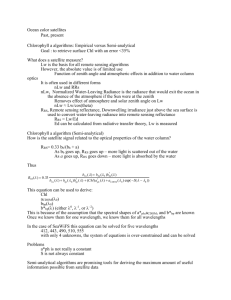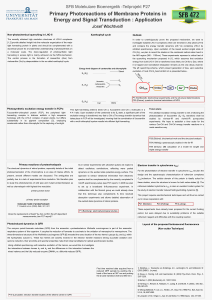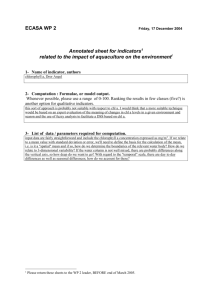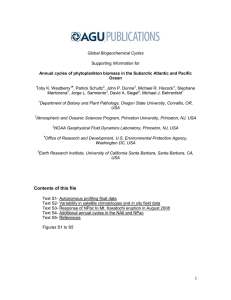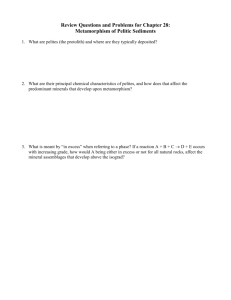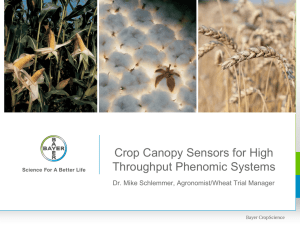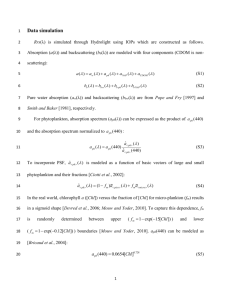Sensing primary production from ocean color
advertisement
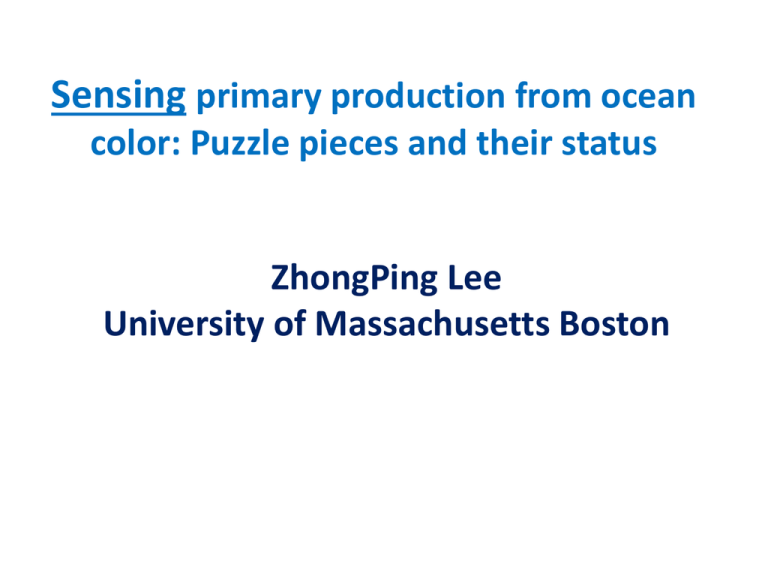
Sensing primary production from ocean color: Puzzle pieces and their status ZhongPing Lee University of Massachusetts Boston An effort started half century ago … From over 7000 measurements Global PP: ~15 Gt/year Longhurst et al (1995): 45-50 Gt C year-1 Antoine et al (1996): 36.5-45.6 Gt C year-1 Behrenfeld and Falkowski (1997): 43.5 Gt C year-1 ~3 times higher than estimates in the 50-60s’! Large spatial differences from different sensing models (Behrenfeld et al 2005) Puzzle pieces to sense PP in the ocean 1. Input energy 3. Phytoplankton index 2. Light at depth (spectral attenuation) 4. Energy conversion (nutrient) (Platt and Sathyendranath, 2007) 1. Input energy PAR (Photosynthetic Available Radiation) (Frouin et al 1989, 2003) Spectral irradiance (Gregg and Carder 1990) 2. Light at depth (spectral attenuation) E d ( , z ) E d ( ,0 ) e Q: How to get Kd(λ) of varying water bodies? K d ( ) z Algorithms to get Kd Current operational standard Method 1: empirical Kd K d ( 490 ) Rrs Rrs(λ1)/Rrs(λ2) Method 2: empirical Rrs Method 3: empirical [Chl] Kd Kd Rrs(λ1)/Rrs(λ2) semi-analytical Rrs semi-analytical a&bb (QAA) KKdd 5 5 1 :1 A ra b ia n S e a GOM B a ltic ( 490 K K dd (4 9 0)) [m ] -1 1 0 .5 0 .3 0 .1 1 0 .5 0 .3 0 .1 0 .0 5 (a: Method 1) (b: Method 2) 0 .0 5 0 .0 3 0 .0 3 0 .0 5 0 .1 0 .3 0 .5 1 3 5 0 .0 3 0 .0 5 -1 0 .1 0 .3 0 .5 1 3 5 -1 K dd(4 9 0 )) - m e a s u re d [m ] ( 490 KKd d(4 9 0 )) - m e a s u re d [m ] ( 490 5 1 :1 A ra b ia n S e a GOM B a ltic 3 -1 0 .0 3 1 :1 A ra b ia n S e a GOM B a ltic 3 9 0 )) [m ] ( 490 KK dd (4 -1 9 0)) [m ] KKdd ((4 490 3 1 0 .5 Oceanic & Coastal waters 0 .3 0 .1 0 .0 5 (c: Method 3) 0 .0 3 0 .0 3 0 .0 5 0 .1 0 .3 0 .5 1 3 5 -1 9 0)) - m e a s u re d [m ] KKdd((4 490 (Lee et al. 2005) Kd through IOPs measured sensed 0.06 0.04 0.02 0.00 350 400 450 500 The NOMAD set (1243 data points) 550 X Data[nm] Wavelength 1 1:1 IOP -1 IOPs-Kd(490) Y Data [m ] -1] Spectral K [m d Y Data 0.08 0.3 0.1 0.03 0.01 0.01 0.03 0.1 X Data Profile K d(490) 0.3 [m-1] 1 Different sun angles: Through IOPs 0.25 0.25 0.15 -1 IOP-basedY K d(490) [m ] Data 0.20 < 30 1.09 30-60 0.99 > 60 0.89 Y Data Ratio-derived Kd(490) [m-1] Empirical ratio 0.10 0.05 0.00 0.00 0.05 0.10 0.15 0.20 X Data Profile-Kd(490) [m-1] 0.20 0.15 < 30 0.99 30-60 1.00 > 60 1.00 0.10 0.05 0.00 0.00 0.05 0.10 0.15 0.20 X Data Profile-Kd(490) [m-1] Spectral Kd can be well derived based on physics! Challenges: How Kd in the UVA/UVB varies globally? 3. Phytoplankton index VGPM: Chl became the index!! (Behrenfeld and Falkowski, 1997) Essence of Rrs-ratio derived Chl product: R rs ( 1 ) Chl fun R ( ) rs 2 R rs G R rs ( 440 ) R rs ( 550 ) R rs ( 440 ) R rs ( 550 ) bb a bb a ( 550 ) b bw ( 440 ) b bp ( 440 ) a ( 440 ) b bw ( 550 ) b bp ( 550 ) a ( 550 ) a ( 440 ) a w ( 550 ) a dg ( 550 ) a ph ( 550 ) Chl * a w ( 440 ) a dg ( 440 ) a ph ( 440 ) Chl * Simple ratio actually involves more than one variable! (Szeto et al 2011, JGR) Simple ratio dismissed spatial/temporal variation! Analytically derived a(443) [m-1] At the center of South Pacific Gyre Rrs-ratio derived Chl [mg/m3] Rrs-ratio derived Chl [mg/m3] Nature of ratio-derived “Chl” May 2009, Global, MODIS Analytically derived a(443) [m-1] Ratio-derived “Chl” is re-scaled total absorption coefficient! 4. Energy conversion (Behrenfeld and Falkowski 1997) (Platt et al, RSE, 2008) Variation of phytoplankton- (or chlorophyll-) specific absorption coefficient (a*ph) contributes largely to the variation of PBopt. “Site-specific and previously published global models of primary production both perform poorly and account for less than 40% of the variance in ʃPP,” (Siegel et al 2001) “significant improvements in estimating oceanic primary production will not be forthcoming without considerable advance in our ability to predict temporal and spatial variability in PBopt”. (Behrenfeld and Falkowski 1997) B PP eu Popt PAR Chl z eu DL Chl is NOT the direction to go. Centered on Chl Both PBopt and Chl have a*ph associated Increase uncertainty in PP PP eu PAR a ph z eu DL Centered on absorption No engagement of a*ph PP estimation based on phytoplankton absorption (aph): Quantum yield for photosynthesis Remotely sensible PP ( z ) ( t , z ) E 0 ( , t , z ) a ph ( , z ) d dt Ocean color aph Phytoplankton index PP (Marra et al 2007, Deep Sea Res.) R2 = 0.84 R2 = 0.78 The Quasi-analytical algorithm (QAA) Rrs() (Lee et al. Appl. Opt., 2002) u ( ) F1 Rrs ( ) η (± Δη) U2 a ( 0 ) ( a ) U1 b bp ( 0 ) F2 u ( 0 ), a ( 0 ), b bw ( 0 ) bbp ( ) bbp ( 0 ) 0 a ( ) F3 u ( ), b bp ( ), b bw ( ) U3 U4 a ph ( 2 ) F4 ( a ( 1 ), a ( 2 ), ( ), ( )) a dg ( 2 ) F5 ( a ( 1 ), a ( 2 ), ( ), ( )) u( ) bb ( ) a ( ) bb ( ) aph(λ) (m-1) Measured vs sensed aph (Lee et al 2004) Absorption-based PP compared with measured PP 10 a p h -c e n te re d C h l-c e n te re d 1 :1 3 1 0 .3 0 .3 1 3 10 m e a s u re d p ro d u c tio n ( m o l/l/d ay ) (Lee et al. 1996) PPeu from model [mg C m-2 d-1] calculated production ( m ol/l/day ) 700 R2 = 0.44 1:1 600 500 R2 = 0.29 400 300 Chl-PPB R2 = 0.74 200 Chl-PPA Aph-PP 100 100 200 300 400 500 600 PPeu from on-deck incubation [mg C m-2 d-1] (Lee et al. 2010) 700 Challenges: Where is the global model for φ? Which ‘ground truth’ we remote-sensors should aim at? Summary: 1. A frame work for sensing primary production is well established. 2. Optical/light related parameters can now be well retrieved from satellite measurements, at least for oceanic waters. 3. Demands support and hard work to understand and quantify photo-physiological effects. 4. Demands true “ground truth”! Questions?
